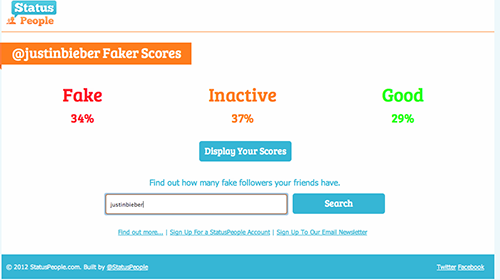

Clients want likes. Lots of likes. And big hits on their youtube videos. And there are plenty of social media experts who will tell you that quantity is key. Here's the thing. Quantity is very very easy to manipulate.
Take that brand with millions of likes. They're fakin'.
Take that viral video with gazillions of views. Guess what? There are services out there to help you in your fakin'.
Which brings us to Twitter and a brand new app from Status People that allows you to call out the fakers. Okay it's actually meant to show how many followers of your own are fake but c'mon. Does anybody really believe Justin Bieber has 26 million real followers? Dude most likely doesn't even update the thing himself. He pays people to do it for him.
The problem is for the millions of Beliebers who do. They're the young, impressionable, and easily duped.
The Status People acknowledge the Fakers app is better suited for those with 10,000 followers or less, but they say it can still be used for larger numbers. As the site says:
"If you're very 'popular' the tool will still provide good insight but may better reflect your current follower activity rather than your whole follower base."
Still. We expect pop stars to inflate their numbers to match their egos. But what about brands? A quick run through of some of the largest on twitter provided these unscientific but still telling results:
The first on the list is the brand supposedly best at social media. Starbucks Coffee:
2,809,003 followers:
23% Fake. 41% inactive = 64% crap.
Lets' try Nike
611,463 followers.
20% Fake. 37% Inactive = 57% crap.
And finally, Kim Kardashian (the brand who was the first one to charge for every tweet).
15,895,144
24% Fake 38% Inactive = 62% crap.
Again it may be unscientific, but you can still get a good sense of what's what.
On the flip side, what brands seem legit?
Oreo.
49,541 followers.
4% fake, 39% inactive = Majority, real.
Ikea.
83,945 followers.
9% Fake, 35% inactive = Majority, real.
Red Bull.
706,753 followers.
13% fake 34% inactive = Majority, real. But just barely.
What I love is Status People's rationale for wanting to do this:
...there are a growing number of Fakers out there. People who buy followers in a vain attempt to build legitimacy. "Look at me I have 20,000 followers, I must know my..." They are essentially trying to game the system and it's important for you to be able to spot them, and steer clear of them. Because ultimately if you're willing to lie about how many friends you have you are not a very trustworthy individual.
In conclusion, huge numbers don't mean much. It's quality not quantity. And just because a lot of brands seem to be on the transparency bandwagon, it doesn't mean they're not fakin'. And as much as social media wizards wants us to believe, engagement is not an organic process.
Finally some sense into the Crazy social media wackiness !!
- reply
PermalinkRAAAH !!! I AM THE 1% ! ... wait..what?
Adland has one percent fakers. 10% inactive and 89% good people following us out of 35,218 followers = ONLY 11% CRAP! Now even better!
Now, when can we start charging ten grand per tweet like Kim does?
- reply
PermalinkIn all seriousness, "followers" and "likes" are the "hits" for the 10s. Remember the 90s? Yeah, the numbers game didn't work then either.
- reply
PermalinkHey,
John Greathouse who blogs at Forbes posted something on the fake celeb accounts today too. Best thing about it is this The following list is ranked from the highest to lowest percentage of real and active Twitter followers, not by each celebrity’s total followers.
- reply
Permalink